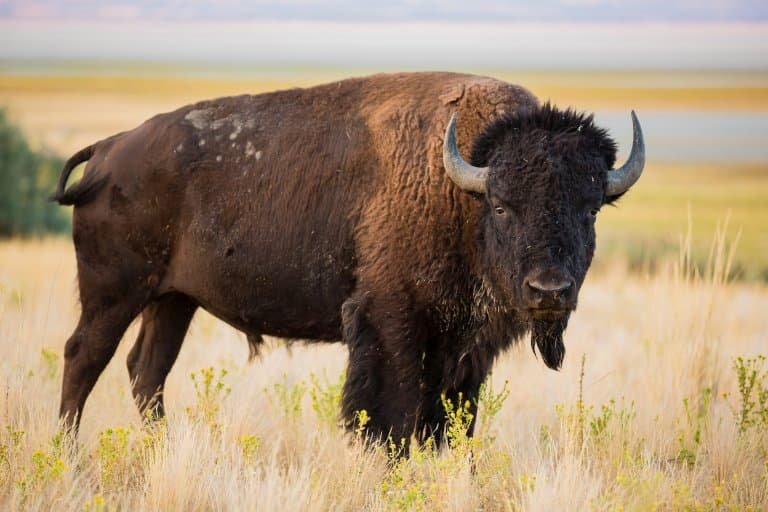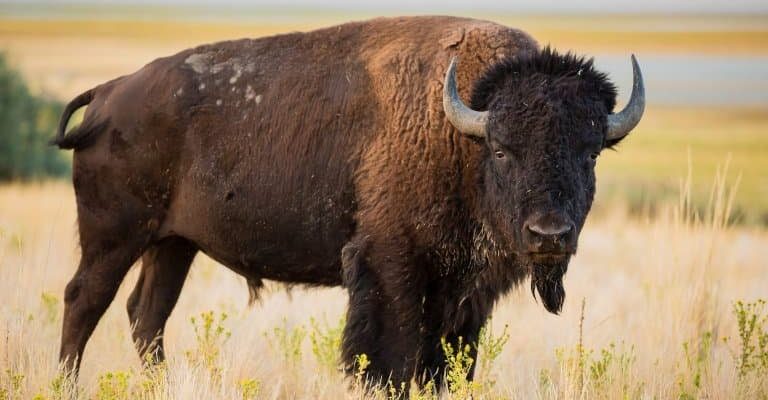
Thinking about bison brings to mind the vast, open spaces of national parks where they thrive. However, despite their iconic status, many people might overlook some incredible facts about them. Let’s dive into the top ten things you probably didn’t know about bison that make them so unique and interesting.
1. Bison Are the Largest Land Mammals in North America
When you picture a bison, it’s hard not to focus on their sheer size. Adult bison can weigh anywhere from 1,000 to 2,200 pounds! To put that into perspective, they can be as heavy as a small car. Standing about six feet tall at the shoulder, these beasts are truly impressive.
Their size isn’t just for show, either. Bison have developed this formidable stature to survive in their natural habitats. Think about how much muscle and strength they need to dig through snow in search of food during harsh winters.
To add to the grandeur, bison possess a unique hump on their backs, formed by the large muscles that help support their massive heads. This feature is crucial for their grazing habits and provides them strength to plow through tough vegetation.
2. They Have a Unique Social Structure
Bison are social creatures and live in herds, but their social structure is quite fascinating. Typically, these herds are made up of females and their young, while adult males tend to roam alone or in small bachelor groups.
Imagine a close-knit community where mothers and calves form bonds that can last for years. The females take care of the young calves, teaching them essential skills for survival. During the breeding season, males will join the female herds to compete for mating opportunities.
This social dynamic is not just about survival; it also plays a profound role in maintaining the health of their populations. Herds help protect individuals from predators through collective vigilance, keeping everyone safe.
3. Bison Are Herbivores with a Unique Diet
What do you think bison eat? Surprisingly, these enormous animals are herbivores, primarily grazing on grasses, sedges, and other types of vegetation. Their diet is not just limited to one type of plant; they enjoy a varied menu, depending on what’s available in their environment.
Bison have a special adaptation that allows them to thrive on tough forage. Their digestive system is designed to break down fibrous plant material efficiently. Thanks to their complex stomachs, they can extract the maximum energy from their food.
This grazing behavior plays a crucial role in maintaining healthy grasslands. As bison move through their habitats, they help control the growth of certain plants, fostering a vibrant ecosystem for other species to thrive.
4. Bison Have a Rich Cultural Significance
Throughout history, bison have held immense cultural importance, especially for Native American tribes. For many tribes, bison were not just a food source; they represented a way of life.
Picture a community relying on bison for food, clothing, tools, and spiritual practices. Tribes utilized nearly every part of the bison, showing deep respect for this incredible animal. The bison’s role extended beyond mere survival; it became intertwined with traditions, stories, and identities.
Even today, bison continue to symbolize strength and resilience, reminding us of the deep connections people have with nature and wildlife.
5. Bison Are Remarkably Adaptive
Here’s the thing: bison are incredibly adaptable animals. They thrive in various environments, from the plains of the Great Plains to the rugged terrain of national parks. Their thick fur acts as insulation against cold weather, while their large size helps them withstand heat in the summer.
They can travel long distances in search of food and water, often covering several miles in one day. In winter, they’re known to dig through snow to reach grasses below—a powerful testament to their determination and adaptability.
This adaptability makes bison an essential part of their ecosystem. They help shape the landscape through their grazing habits, promoting biodiversity and ensuring the health of grasslands.
6. Bison Are a Conservation Success Story
Once on the brink of extinction due to overhunting and habitat loss, bison have made a remarkable comeback. In the late 1800s, their population dwindled to fewer than 1,000 individuals. However, conservation efforts in the 20th century helped revive their numbers.
Thanks to dedicated wildlife preservation initiatives, bison can now be found in national parks and reserves across North America. Their resurgence is often seen as a beacon of hope for conservation efforts, showcasing how collective action can lead to positive change.
Visiting a wildlife reserve or national park is a way to appreciate this success firsthand. It’s not just about watching these majestic creatures in their habitats but also understanding the broader implications of wildlife conservation.
7. They Have Unique Communication Methods
Bison communicate with each other through a series of sounds and body language. You might be surprised to learn that they use grunts, snorts, and bellows to convey different messages. For instance, a low grunt may signal contentment, while a loud bellow can alert others to potential danger.
In addition to vocalizations, bison have a rich repertoire of body language. They use movements and postures to express emotions, from aggression to affection. Observing these interactions can give you insights into their social structure and daily life.
Effective communication is vital for their survival, helping them stay connected with their herd and react to threats.
8. Bison Can Run Fast
You might think that with all that bulk, bison would be slow movers. But here’s the thing—bison can run at speeds up to 35 miles per hour! For such large animals, that’s impressive.
When they feel threatened, bison can burst into a sprint, showcasing their incredible strength and agility. It’s fascinating to watch them move gracefully despite their size, whether it’s during a chase or simply to navigate their terrain.
This speed is another reason why they have few natural predators besides humans. A quick getaway is essential for their survival in the wild.
9. Bison Matter for Ecosystem Health
The role of bison in their ecosystems extends far beyond their grazing habits. These animals help create habitats for other species, promoting biodiversity. As they trample and graze, they encourage the growth of various plants, which can benefit smaller animals and insects.
Bison also create wallows—depressions in the ground where they roll in the mud. These wallows fill with water during rains, creating small ponds that attract birds and other wildlife. Imagine a busy ecosystem thriving because of the intentional behavior of one species!
In this way, bison play a critical role in maintaining balanced ecosystems, highlighting the interconnectedness of all living things.
10. The American Bison is a National Symbol
In recognition of its cultural and ecological significance, the bison was designated the national mammal of the United States in 2016. This honor reflects its historical role in the American landscape and its importance in Native American cultures.
Picture the bison standing proudly on our national emblem, reminding us of the values of strength, resilience, and connection to nature. This designation also serves as a call to action for conservation initiatives, ensuring that future generations can experience the majesty of bison in the wild.
The next time you think about bison, remember their journey and the vital roles they play in our ecosystems and culture.
In conclusion, bison are much more than just big animals wandering the plains. They are fascinating creatures with a rich history and critical importance within their environments. Understanding these facts not only deepens our appreciation for bison but also highlights the importance of conservation efforts in protecting these iconic animals for generations to come.

